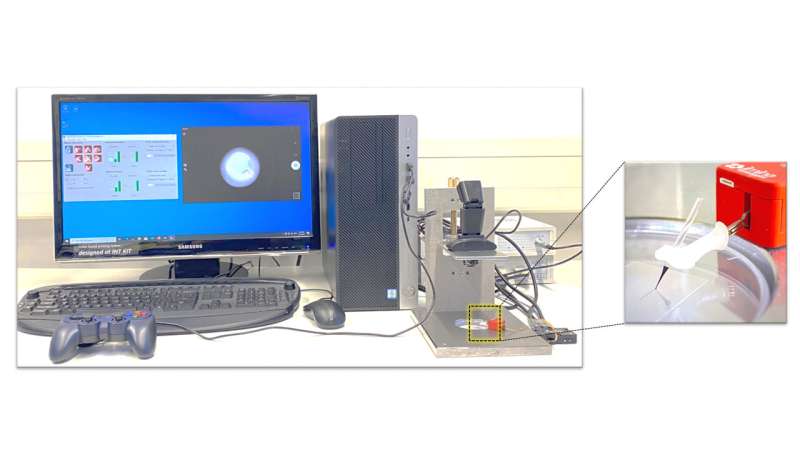Microplotter setup. Credit: Michael Hirtz, Karlsruhe Institute of Technology
Advances in intuitive microwriting devices that can print microstructures could pattern electric circuits and more. The setup, featuring a robot arm to hold the micropen, deposits ink onto the surface, much like writing by hand with a fountain pen.
In Review of Scientific Instruments, researchers from Germany and China outline the development of a flexible and easy-to-use micropen setup, capable of directly writing on surfaces to a microprecise level.
The micropen is held over an ink reservoir as ink is drawn into the pen nozzle. Once filled, the nozzle is positioned for writing onto a tabletop surface.
When the pen meets the surface, ink transfers from the nozzle, and the robot arm is manually manipulated for desired patterns. When the writing is complete, the pen is removed from the surface.
"The setup is an example of how easy and intuitively micromanipulator-based micropatterning can be, and how complex structures that are not compatible with conventional lithography approaches can be accessed," said author Michael Hirtz.
Microarrays, lines, curves, and other structures can be printed in real time using the micropen, and could be used in biological or microelectronic labs, using biomaterial or conductive ink to pattern live cells or circuits. The pen also has potential applications that include molding, embossing, aerosol printing, and inkjet printing.
"By using our setup, or similarly designed ones, it will be possible to pattern into existing devices, microreactors, or hard-to-reach surfaces, on the fly and intuitively," said Hirtz. "This micropen can work with many different types of inks, in a timely and suitable way, enabling users to write in a controlled, microprecise level."
More information: High-precision tabletop microplotter for flexible on-demand material deposition in printed electronics and device functionalization, Review of Scientific Instruments, DOI: 10.1063/5.0061331
Journal information: Review of Scientific Instruments
Provided by American Institute of Physics
























